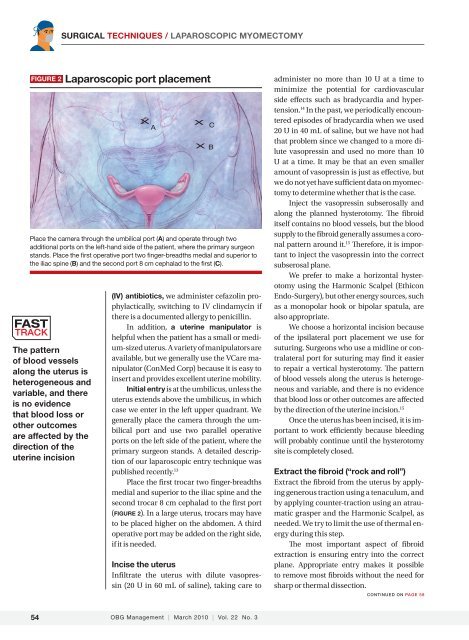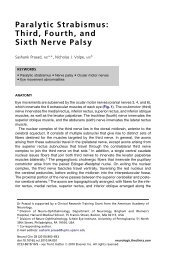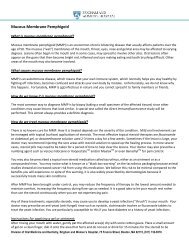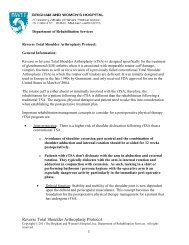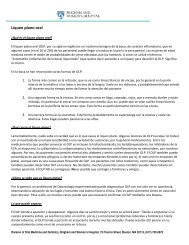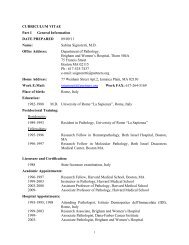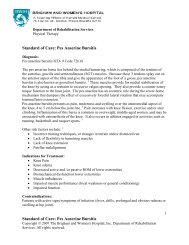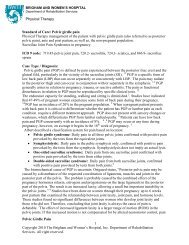Laparoscopic Myomectomy - Brigham and Women's Hospital
Laparoscopic Myomectomy - Brigham and Women's Hospital
Laparoscopic Myomectomy - Brigham and Women's Hospital
Create successful ePaper yourself
Turn your PDF publications into a flip-book with our unique Google optimized e-Paper software.
SURGICAL TECHNIQUES / LAPAROSCOPIC MYOMECTOMY<br />
FIGURE 2 <strong>Laparoscopic</strong> port placement<br />
Place the camera through the umbilical port (A) <strong>and</strong> operate through two<br />
additional ports on the left-h<strong>and</strong> side of the patient, where the primary surgeon<br />
st<strong>and</strong>s. Place the first operative port two finger-breadths medial <strong>and</strong> superior to<br />
the iliac spine (B) <strong>and</strong> the second port 8 cm cephalad to the first (C).<br />
The pattern<br />
of blood vessels<br />
along the uterus is<br />
heterogeneous <strong>and</strong><br />
variable, <strong>and</strong> there<br />
is no evidence<br />
that blood loss or<br />
other outcomes<br />
are affected by the<br />
direction of the<br />
uterine incision<br />
54<br />
X A<br />
X<br />
X B<br />
(IV) antibiotics, we administer cefazolin prophylactically,<br />
switching to IV clindamycin if<br />
there is a documented allergy to penicillin.<br />
In addition, a uterine manipulator is<br />
helpful when the patient has a small or medium-sized<br />
uterus. A variety of manipulators are<br />
available, but we generally use the VCare manipulator<br />
(ConMed Corp) because it is easy to<br />
insert <strong>and</strong> provides excellent uterine mobility.<br />
Initial entry is at the umbilicus, unless the<br />
uterus extends above the umbilicus, in which<br />
case we enter in the left upper quadrant. We<br />
generally place the camera through the umbilical<br />
port <strong>and</strong> use two parallel operative<br />
ports on the left side of the patient, where the<br />
primary surgeon st<strong>and</strong>s. A detailed description<br />
of our laparoscopic entry technique was<br />
published recently. 13<br />
Place the first trocar two finger-breadths<br />
medial <strong>and</strong> superior to the iliac spine <strong>and</strong> the<br />
second trocar 8 cm cephalad to the first port<br />
(FIGURE 2). In a large uterus, trocars may have<br />
to be placed higher on the abdomen. A third<br />
operative port may be added on the right side,<br />
if it is needed.<br />
Incise the uterus<br />
Infiltrate the uterus with dilute vasopressin<br />
(20 U in 60 mL of saline), taking care to<br />
OBG Management | March 2010 | Vol. 22 No. 3<br />
C<br />
administer no more than 10 U at a time to<br />
minimize the potential for cardiovascular<br />
side effects such as bradycardia <strong>and</strong> hypertension.<br />
14 In the past, we periodically encountered<br />
episodes of bradycardia when we used<br />
20 U in 40 mL of saline, but we have not had<br />
that problem since we changed to a more dilute<br />
vasopressin <strong>and</strong> used no more than 10<br />
U at a time. It may be that an even smaller<br />
amount of vasopressin is just as effective, but<br />
we do not yet have sufficient data on myomectomy<br />
to determine whether that is the case.<br />
Inject the vasopressin subserosally <strong>and</strong><br />
along the planned hysterotomy. The fibroid<br />
itself contains no blood vessels, but the blood<br />
supply to the fibroid generally assumes a coronal<br />
pattern around it. 15 Therefore, it is important<br />
to inject the vasopressin into the correct<br />
subserosal plane.<br />
We prefer to make a horizontal hysterotomy<br />
using the Harmonic Scalpel (Ethicon<br />
Endo-Surgery), but other energy sources, such<br />
as a monopolar hook or bipolar spatula, are<br />
also appropriate.<br />
We choose a horizontal incision because<br />
of the ipsilateral port placement we use for<br />
suturing. Surgeons who use a midline or contralateral<br />
port for suturing may find it easier<br />
to repair a vertical hysterotomy. The pattern<br />
of blood vessels along the uterus is heterogeneous<br />
<strong>and</strong> variable, <strong>and</strong> there is no evidence<br />
that blood loss or other outcomes are affected<br />
by the direction of the uterine incision. 15<br />
Once the uterus has been incised, it is important<br />
to work efficiently because bleeding<br />
will probably continue until the hysterotomy<br />
site is completely closed.<br />
Extract the fibroid (“rock <strong>and</strong> roll”)<br />
Extract the fibroid from the uterus by applying<br />
generous traction using a tenaculum, <strong>and</strong><br />
by applying counter-traction using an atraumatic<br />
grasper <strong>and</strong> the Harmonic Scalpel, as<br />
needed. We try to limit the use of thermal energy<br />
during this step.<br />
The most important aspect of fibroid<br />
extraction is ensuring entry into the correct<br />
plane. Appropriate entry makes it possible<br />
to remove most fibroids without the need for<br />
sharp or thermal dissection.<br />
CONTINUED ON PAGE 58


